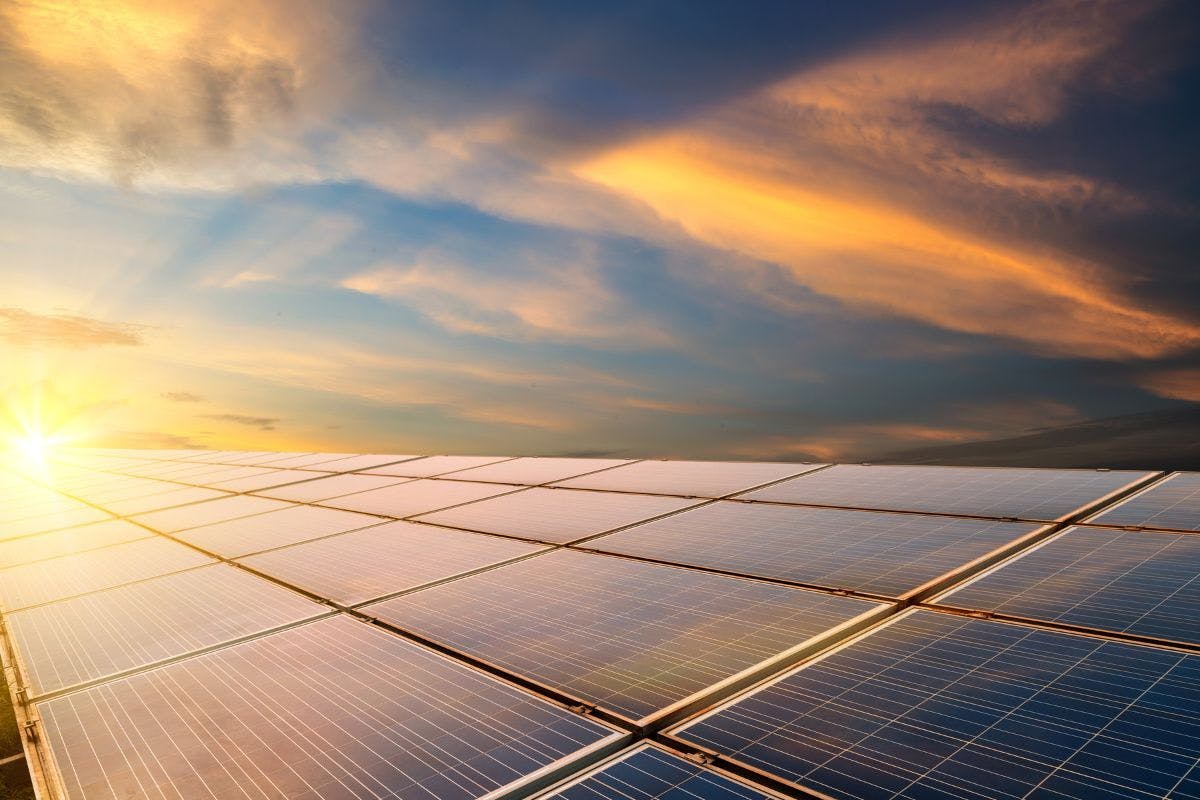Thin-Film Solar Panels Guide: Who Uses Them?
Last edited

Author
Andrew Blok
Electrification and Solar Writer and Editor

Editor
Andrew Giermak
Solar and Electrification Writer and Editor

Rooftop solar panels can open the door to decades of lower electricity bills, turning limited roof space into valuable real estate.
Since most homeowners don't have unlimited space, most residential panels use monocrystalline solar cells, which offer the best combination of efficiency, cost, and size. Still, other technologies, like thin-film solar cells, have their place in the solar industry, even if it's not on your roof.
See how much you can save by going solar with Palmetto
What Are Thin-Film Solar Panels?
Thin-film solar panels harness energy from direct sunlight using one or more thin layers of semiconducting materials placed on a suitable base such as glass, plastic, or metal.
Thin-film solar cells are much thinner than the monocrystalline silicon solar cells that make up most residential solar panels. This makes them suitable for use in flexible solar panels, though not all thin-film solar panels are flexible.
Thin-film solar cells are made using different materials than monocrystalline solar panels. Common thin-film technologies are cadmium telluride (CdTe), copper indium gallium diselenide (CuInSe2), and amorphous silicon (a-Si).
Differences Between Thin-Film Solar Panels and Standard Silicon Solar Panels
The key differences between thin-film solar panels and standard silicon solar panels are their size, strength, and cost. Unlike rigid silicon solar panels, thin-film panels can be as slim as a piece of paper and cheaper to produce, ship, and install. They can be flexible enough to mount on curved surfaces.
Today, traditional monocrystalline photovoltaic solar panels are typically more efficient and durable than their thin-film counterparts. Because they’re less efficient, thin-film cells need more space to generate the same amount of electricity as standard silicon solar panels.
Advantages and Disadvantages of Thin-Film Solar Panels
Compared to the more common silicon solar collectors, thin-film solar panels come with a few distinct advantages and disadvantages.
Advantages
- Lower cost: Thin-film solar panels are generally cheaper to manufacture than traditional modules.
- Lighter weight: Thin-film solar panels are easier to transport and install on a variety of surfaces.
- More flexible: Some thin-film solar panels are flexible and can be installed on curved surfaces.
Disadvantages
- Less efficiency: Generally less efficient than traditional panels, thin-film installations require more space to produce the same amount of electricity.
- Reduced durability: Thin-film solar panels may be more prone to cracks, breaks, and malfunctions from weather conditions like rain or snow.
See how much you can save by going solar with Palmetto
The Primary Thin-Film Solar Cell Materials
Ready to get technical? Here is a detailed look at the three main materials used in thin-film solar panels today:
Amorphous silicon (a-Si) solar panels
Like the monocrystalline silicon solar panels that might be installed on your roof, amorphous silicon panels are made largely of silicon. Unlike those rooftop panels, the silicon here is amorphous, or non-crystalline.
Amorphous silicon cells generally are less efficient but still perform well in a variety of light intensities.
Amorphous silicon solar panels are made by depositing a thin layer of amorphous silicon onto a surface using chemical vapor deposition. The resulting material has a low thermal conductivity, which means it can absorb more heat than traditional crystalline silicon photovoltaic cells without overheating.
While cheap to manufacture and produce, a-Si panels tend to degrade quicker than other types of thin-film solar panels, and have difficulty operating at temperatures below freezing.
Copper indium gallium selenide (CIGS) solar panels
As one of the most popular thin-film technologies, CIGS solar cells use a series of copper, indium, gallium, and selenide layers to capture sunlight and generate electricity. CIGS panels utilize a multi-step process to collect and separate electrical charges, resulting in high-efficiency power production.
Suitable for building integration and several different flexible applications, CIGS research has created modules with thin-film solar panel efficiency levels up to 23% and rising, comparable to traditional solar panels. However, integrating copper, gallium, indium, and diselenide into one simple manufacturing process has made commercial production of the technology more difficult and expensive than other thin-film cells.
Cadmium telluride (CdTe) solar panels
Cadmium telluride (CdTe) solar panels are known for their quick and inexpensive development process. Cadmium telluride solar panels have achieved similar efficiencies as traditional silicon solar panels, with reduced costs of production.
Flexible and ultra-thin, CdTe panels are among the most researched and tested technologies in new solar generation. However, the toxicity of the materials in CdTe solar panels has raised some environmental concerns about the disposal or recycling of old panels.
Should You Get Thin-Film Solar Panels for Your Home?
Thin-film solar panels are currently most often utilized in large utility-scale installations or on the rooftops of commercial buildings with ample space. Since many residential roofs are limited in total surface area, they’re not a good fit. For now, monocrystalline solar panels are used in almost all residential applications.
If you’re curious about how much you can save by going solar, check out Palmetto’s free solar design and savings estimate tool.
See what solar can do for you:
Frequently Asked Questions
Are thin-film solar panels more expensive?
Thin-film solar panels vary in cost but can be cheaper to manufacture than other types of solar panels.
Can thin-film solar panels go on your roof?
Because they need more space to generate the same amount of electricity, they’re not a good fit for residential roofs.
Disclaimer: This content is for educational purposes only. Palmetto does not provide tax, legal, or accounting advice. Please consult your own tax, legal, and accounting advisors.


